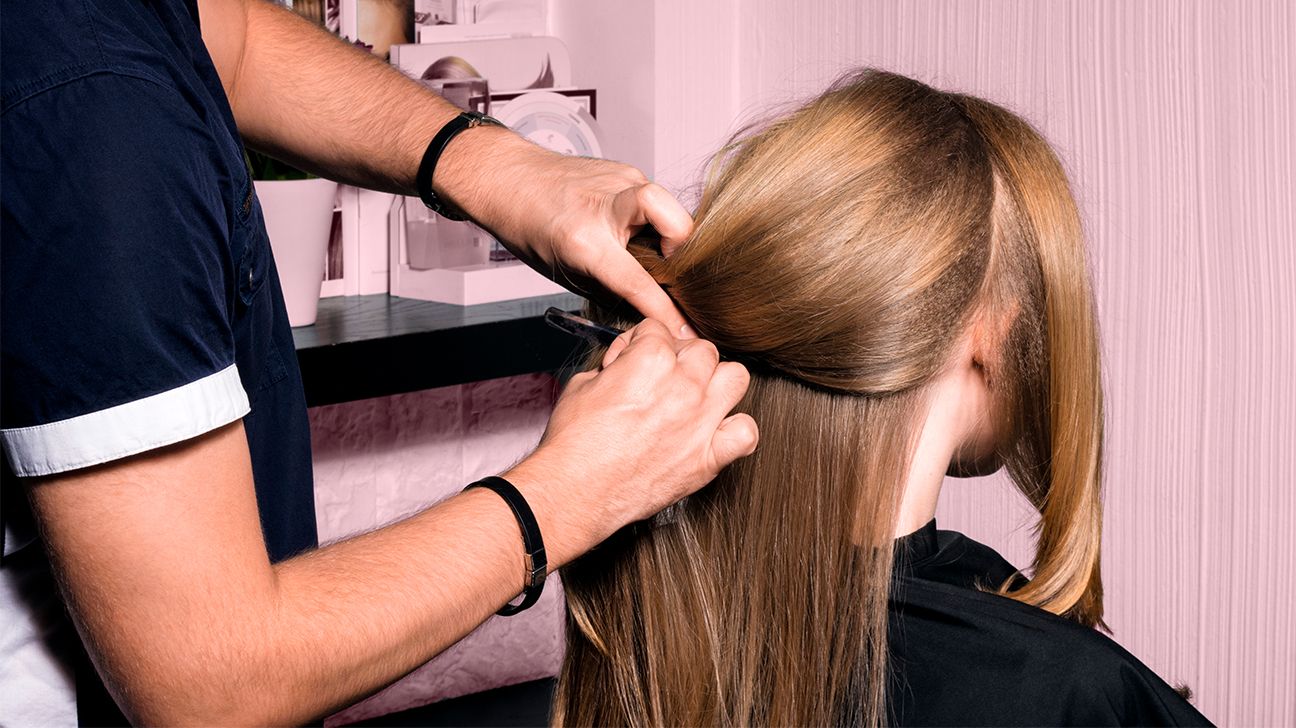Greasy hair is a common occurrence and nothing to be ashamed of. But if greasy hair isn’t your vibe, there are lots of effective ways you can de-greasify your luscious locks.
Greasy hair got you down? Well, fear not! Here are 10 hacks to get your greasy hair back on track. We also have a detailed explanation of the causes of greasy hair, plus prevention tips.
 Drouk/Getty Images
Drouk/Getty ImagesBefore we get into the nitty-gritty, err, nitty-greasy… here are 10 tips to help you treat and prevent greasy hair:
- Find the right shampoo for your unique hair needs, and wash it every other day.
- Don’t put too much conditioner, and avoid using conditioner on your scalp.
- Rinse your hair thoroughly after each wash.
- Avoid styling products that contain oil-producing ingredients, and don’t overdo it with hot tools.
- Wash your hair after using a hat or helmet, and keep your hats clean.
- Use dry shampoo to absorb excess oils and moisture.
- Use a clarifying shampoo.
- Use natural haircare products like apple cider vinegar.
- Adjust your diet, avoiding foods that lead to excessive oil production.
- Find ways to reduce your stress.
Greasy hair happens when there’s an excess or buildup of sebum, the oil that our scalp produces to keep our locks healthy. These oils are meant to protect our precious hair proteins and keep everything in balance. But sometimes things go haywire. But why?
Here are some common causes:
- Genetics. Your DNA could be the reason you’re an oil-making machine. If you’re predisposed to oily skin, then you’re predisposed to an oily scalp, too.
- Diet. Your diet might also be the culprit. Eating a lot of sugar and dairy products might kick your sebaceous glands into high gear.
- Hormones. Those oil-producing glands on your skin also go aggro if your hormones are out of whack. So things like menstrual cycles, puberty, and pregnancy can all play a part.
- Sweat. Whether you’re sweaty from working out or spending time out in the sun, sweat can lead to an oily scalp and greasy hair.
- Haircare routine. You might be washing your hair not enough, or too often. This can throw the oil balance of your hair off kilter.
- Products. Harsh products that strip away all your natural oils will cause your oil glands to overreact and make too much oil. On the other hand, conditioners that add too much moisture to your hair might build up over time, turning it into a gloppy muck.
- Hair type. People with fine hair are at a higher risk of a greasy scalp. Fine hair can’t absorb as much sebum and moisture compared to thicker hair. Also if you have fine hair, you probs have more hair follicles per square inch. That means you might produce more sebum than those with thick hair.
Ready to show that grease who’s boss? Here are 10 ways to manage greasy hair.
If your hair tends to be oily, you should prob wash it every other day. But don’t overdo it. The more you wash your hair, the more you strip your hair of its natural oils. This will kick your follicles into grease-making mode.
Also, it might help to use a gentle shampoo or products that contain lauryl sulfates or sulfosuccinates. These chemicals work to remove sebum from the hair. Balance is the key here, so nothing too harsh.
And only use a little bit of shampoo, about the size of a quarter. (Remember coins?) Gently massage the little dollop into your scalp and let it froth up on its own. Don’t worry about getting the shampoo all the way to the tips of your hair. Focus on the follicles where the oil is produced.
Conditioner adds moisture and luster to your hair. So if you don’t want to add more greasiness, avoid putting it on your scalp. Instead, spread a little conditioner just on your tips. If you have shorter hair or thinning hair, you may want to skip the conditioner altogether.
Remember, every hair type has unique needs. It might take some trial and error, but you’ll eventually find one that works for you.
Make sure to thoroughly rinse out any shampoo or conditioner. Otherwise, all sorts of residue might literally stick around. When rinsing, go for some tepid water. Hot water will totally strip your hair of its oils, alerting those sebaceous glands to kick into overdrive. Rinsing your hair with cooler water will also help your scalp stay healthy by promoting blood flow on your scalp.
Avoid styling products that contain silicone or products that add too much moisture, like oils. Again, these will not only weigh down your hair and make it look oilier, but they could also throw your scalp’s moisture balance out of whack. Reach for a lighter product with a spray applicator.
Also, be careful not to overdo it with hot styling tools. Adding heat to your hair will definitely up the grease factor. To keep things balanced, try to air dry your hair at least once or twice a week.
It’s a great idea to wear a hat to protect your skin and hair against UV damage, especially in the summer. And it’s super wise to wear a helmet while biking. But anything that covers your head will also make your scalp sweat. So be sure to wash your hair after wearing a hat or a helmet.
Dry shampoo can be a great option for quickly reducing the oiliness of your hair. These products are usually powders or sprays that absorb the grease between washings. Be careful, though. Using too much dry shampoo will leave your hair full of gunky residue which could lead to dandruff or other scalp irritation.
Pro tip: If you want to experiment with dry shampoo, put a little of it into your brush and then work it into your hair so it gets all the way down to your roots.
As you tweak your hair routine, think about using a clarifying shampoo once a week. Clarifying shampoos give your hair a sort of deep clean, lifting out the residue that can build up from other shampoos, conditioners, dry shampoos, styling products, or air pollutants.
If you want to go the DIY route to tame your oily hair, there are a few options. Some styling professionals recommend trying apple cider to reduce the greasiness. Make a mixture of one part apple cider vinegar and eight parts water, let it soak in your hair for a few minutes. Then rinse it out with tepid water.
Aloe vera and coconut oil also help to soothe your scalp and remove excess oils. But make sure to use them sparingly and only on your scalp as they are also natural moisturizers.
Cornstarch is a great DIY dry shampoo. Also, in a small study, green tea products were shown to reduce sebum production in the skin.
As we mentioned, your diet might be the culprit in causing your glands to make more skin oils. To regain a balance, opt for a diet rich in whole grains, fish, and vitamin E. This will help regulate oil production.
Foods containing fatty acids also help balance your sebum production and promote healthier hair. Fish, nuts, seeds, plant oils, and fortified foods like milk and yogurt are all secret weapons for luscious locks.
Greasy hair can be triggered by a medley of factors like hormonal imbalances, your genetics, your diet, your hair care habits, or the weather. Glands in your scalp produce that oil we call sebum. Sometimes, those glands go into overdrive, turning your locks into a greasy mess. Fine hair loves to soak up sebum like a sponge.
There are some simple hair hacks that can help de-grease your hair. Try washing your hair every other day with a smidgen of gentle shampoo, avoiding harsh products that strip away your precious natural oils, and applying it only to your scalp. If you like using conditioner, apply it sparingly and just to the tips of your hair. Rinse with tepid water to keep that residue at bay. Remember, hot water will send your sebaceous glands into overdrive, leaving you slicker than a car dealer.
Styling products with silicone or excessive moisture are the enemy, just like those fiery styling tools that turn up the greasiness dial. Dry shampoo, the hero of the unwashed, can save the day. Just don’t go overboard and turn your head into a powdery mess.

 6 months ago
75
6 months ago
75









 Bengali (BD) ·
Bengali (BD) ·  English (US) ·
English (US) ·